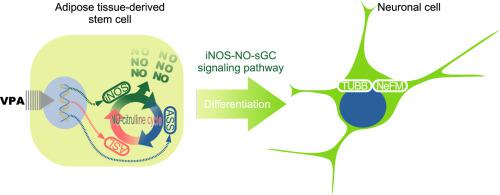Nitric Oxide ( IF 3.9 ) Pub Date : 2020-10-28 , DOI: 10.1016/j.niox.2020.10.006 Daiki Hayashi 1 , Takumi Okubo 1 , Takehito Suzuki 1 , Yoko Miyazaki 1 , Kazuaki Tanaka 1 , Makoto Usami 2 , Tatsuya Takizawa 1

|
Valproic acid (VPA) remarkably promotes the differentiation of adipose tissue-derived stem cells (ASCs) to mature neuronal cells through nitric oxide (NO) signaling due to up-regulated inducible NO synthase (iNOS) as early as within 3 days. Here, we investigated mechanisms of VPA-promoted neuronal differentiation of ASCs concerning the NO-citrulline cycle, the metabolic cycle producing NO. Cultured rat ASCs were differentiated to mature neuronal cells rich in dendrites and expressing a neuronal marker by treatments with VPA at 2 mM for 3 days and subsequently with the neuronal induction medium for 2 h. Inhibitor (α-methyl-d, l-aspartic acid, MDLA) of arginosuccinate synthase (ASS), a key enzyme of the NO-citrulline cycle, abolishes intracellular NO increase and VPA-promoted neuronal differentiation in ASCs. l-Arginine, the substrate of iNOS, restores the promotion effect of VPA, being against MDLA. Immunocytochemistry showed that ASS and iNOS were increased in ASCs expressing neurofilament medium polypeptide (NeFM), a neuronal marker, by VPA and NIM synergistically. Real-time RT-PCR analysis showed that mRNAs of Ass and arginosuccinate lyase (Asl) in the NO-citrulline cycle were increased by VPA. Chromatin immunoprecipitation assay indicated that Ass and Asl were up-regulated by VPA through the acetylation of their associated histone. From these results, it was considered that VPA up-regulated the whole NO-citrulline cycle, which enabled continuous NO production by iNOS in large amounts for potent iNOS-NO signaling to promote neuronal differentiation of ASCs. This may also indicate a mechanism enabling short-lived NO to function conveniently as a potent signaling molecule that can disappear quickly after its role.
中文翻译:

丙戊酸上调整个 NO-瓜氨酸循环以获得有效的 iNOS-NO 信号,以促进脂肪组织衍生干细胞的神经元分化
由于诱导型一氧化氮合酶 (iNOS) 上调,丙戊酸 (VPA) 最早可在 3 天内通过一氧化氮 (NO) 信号显着促进脂肪组织衍生干细胞 (ASC) 向成熟神经元细胞的分化。在这里,我们研究了 VPA 促进 ASC 神经元分化的机制,涉及 NO-瓜氨酸循环,代谢循环产生 NO。通过用 2 mM 的 VPA 处理 3 天,然后用神经元诱导培养基处理 2 小时,培养的大鼠 ASC 分化为富含树突并表达神经元标记的成熟神经元细胞。精氨琥珀酸合成酶 (ASS) 的抑制剂(α-甲基-d, l-天冬氨酸,MDLA)是 NO-瓜氨酸循环的关键酶,可消除 ASC 中细胞内 NO 增加和 VPA 促进的神经元分化。l-精氨酸,iNOS的底物,恢复了VPA对MDLA的促进作用。免疫细胞化学显示,通过 VPA 和 NIM 协同表达神经丝介质多肽 (NeFM)(一种神经元标记物)的 ASC 中 ASS 和 iNOS 增加。实时RT-PCR分析显示,mRNA的驴和精氨琥珀酸裂合酶(黄芪甲甙中的NO瓜氨酸周期)分别增加了VPA。染色质免疫沉淀试验表明Ass和AslVPA 通过其相关组蛋白的乙酰化上调。从这些结果可以看出,VPA 上调了整个 NO-瓜氨酸循环,这使得 iNOS 能够持续大量产生 NO,从而产生有效的 iNOS-NO 信号传导,从而促进 ASC 的神经元分化。这也可能表明一种机制使短寿命 NO 能够方便地作为有效的信号分子发挥作用,在其作用后可以迅速消失。

























 京公网安备 11010802027423号
京公网安备 11010802027423号